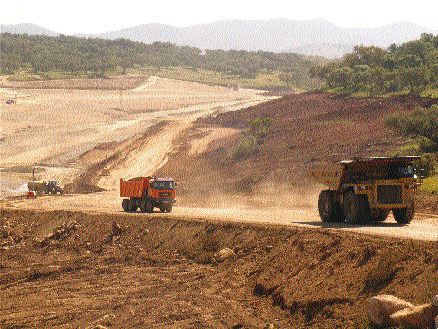Traditionally a gold miner,
The company expects to cold commission the plant with water over the balance of September; the first batch of ore will be run through in early November. That’s a couple of months later than originally planned owing to a 3-week delay in permitting construction of an 18-km power line; the last segment of the line is currently being built and should be ready by mid-October.
Initially, a contractor-run, open-pit mining operation will target a reserve totalling 15.7 million tonnes running 0.7% nickel, 0.5% copper, and 0.5 gram platinum group elements (PGE) per tonne, based on a cutoff grade of 0.25% nickel. The life-of-mine strip ratio is estimated at 5.4 to 1.
The Aguablanca nickel-copper-PGE deposit occurs in a gabbro-norite intrusive body along the north contact of the Santa Olalla granodiorite complex. It comprises two steeply dipping, northwest-trending bodies that are truncated by northeast-oriented, post-mineralization faults. The main mineralized zone reaches a depth of around 450 metres, beneath which a south-dipping, higher-grade mineralized zone is bounded by east-west and northeast-trending faults.
Over its 10.5 years of operation, the mine is expected to annually churn out 8,200 tonnes nickel in concentrate, equivalent to about half the European Union’s current annual output. The concentrate will also include some 6,100 tonnes copper and 23,000 oz. PGE byproducts. A long-term, off-take agreement will see Switzerland’s
Processing at Aguablanca will involve primary crushing, semi-autogenous grinding, pebble crushing, ball milling, flash flotation, three stages of nickel flotation, concentrate thickening and filtration to produce a bulk copper-nickel-PGE concentrate. The 1.5-million-tonne-per-year flotation plant, which has additional milling capacity of 300,000 tonnes per year, can also produce separate nickel and copper concentrates with little loss of nickel to the copper concentrate.
Overall nickel recovery to the concentrate is pegged at about 82%, copper at 85%, and 75% for platinum, palladium and cobalt. The resulting concentrate will grade around 10% nickel, 7% copper, 6 to 10 grams combined platinum and palladium per tonne, plus 0.15-0.2% cobalt. The product will be trucked some 140 km to the southwestern Spanish port of Huelva for shipping.
On the financial front, Rio Narcea expects Aguablanca to generate more than US$60 million in annual cash flow, based on a nickel price of US$6 per lb., a copper price of $1 per lb., and an exchange rate of US$1.25 to the euro. The cash flow slows to around US$25 million at a nickel price of US$3 per lb. Cash costs are pegged at US$1.93 per lb. nickel, based on a nickel price of US$3 per lb.
As it stands, the orebody has been pre-stripped and the oxidized ore has been mined and stockpiled; some 100,000 tonnes of fresh ore is ready for extraction once the plant is ready for feed.
In all, the project carries a price tag of 70 million euros; by the end of June some 48 million euros had been spent. The balance of the project’s capital will be covered via cash on hand, a subsidized loan of 5 million euros from Spain’s Ministry of Science and Technology, and the balance remaining on a 6-million-euro value-added-tax credit facility from London-based Barclays Bank.
Meanwhile, the company has already begun construction of a 3-km decline to access higher-grade mineralization below Aguablanca’s pit. The decline has been advanced some 420 metres from the portal, and is expected to reach the high-grade nickel zone in the second quarter of 2005, at a cost of about 5 million euros.
The 5-metre-by-5-metre decline will reach a depth of 450 metres and allow for underground infill drilling, which the company plans to begin in the first half of 2005. It has been designed with an arched top (to allow for the installation of a conveyor system), and will be lined with concrete to ultimately facilitate underground production.
Based on limited drilling so far, the company figures the underground portion of Aguablanca could produce between 200,000 and 300,000 tonnes of ore as soon as 2006. That would boost cash flow by between US$10 million and US$20 million.
High-grade nickel intersections below the pit are as follows:
— 48 metres averaging 1.77% nickel and 0.9% copper;
— 42 metres grading 1.18% nickel and 1% copper;
— 40 metres of 1.10% nickel and 0.7% copper;
— 34 metres running 1.24% nickel and 0.7% copper; and
— 46 metres of 0.79% nickel and 0.87% copper.
On the exploration front, work continues on nickel sulphide, PGE and iron oxide copper-gold targets on the Ossa Morena belt in southern Spain and Portugal, where the company has a 6,000-sq.-km land package. So far, the company has identified at least 18 mineralized nickel-sulphide targets and 10 copper-gold targets. Some 2,500 metres of exploration drilling is planned for the Ossa Morena targets during the second half of 2004.
In other news, Rio recently wrapped up its acquisition of Defiance Mining after its shareholders overwhelmingly approved the deal at the end of August; court approval was obtained in early September. Under the deal, Defiance shareholders will receive one share of Rio Narcea for every 5.25 common shares of Defiance.
Defiance’s key asset is the permitted, US$48.4-million Tasiast gold project in Mauritania, West Africa. The proposed 4-pit operation is expected to produce 110,000 oz. gold from 1.2 million tonnes of oxide ore in each of the first three years; production will slip to around 102,000 oz. per year over the subsequent 5 years. The operation generates a rate of return of 22.5% at a gold price of US$400 per oz.
Rio Narcea is currently planning a 5,000-metre drilling campaign to test the depth extension of the high-grade zone beneath Tasiast’s main pit. The holes will also aim to condemn areas in anticipation of construction later this year. If all goes to plan, the mine will enter production in early 2006.
The Defiance acquisition has boosted Rio Narcea’s issued and outstanding shares to about 132.6 million.


Be the first to comment on "Rio Narcea in Spanish transition"